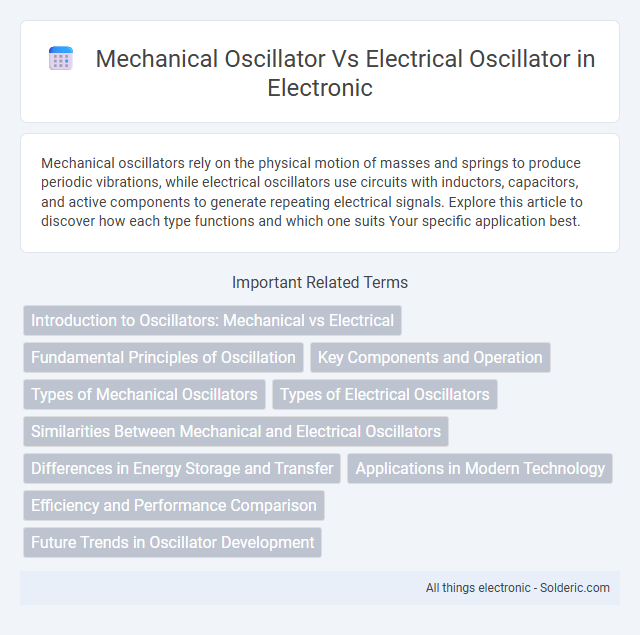Mechanical oscillators rely on the physical motion of masses and springs to produce periodic vibrations, while electrical oscillators use circuits with inductors, capacitors, and active components to generate repeating electrical signals. Explore this article to discover how each type functions and which one suits Your specific application best.
Comparison Table
| Feature | Mechanical Oscillator | Electrical Oscillator |
|---|---|---|
| Definition | Device generating periodic mechanical motion. | Device generating periodic electrical signals. |
| Energy Type | Mechanical energy (kinetic and potential). | Electrical energy (voltage and current). |
| Examples | Pendulum, tuning fork, mass-spring system. | LC circuit, RC circuit, crystal oscillator. |
| Frequency Range | Typically low frequency (Hz to kHz). | Wide range (Hz to GHz). |
| Applications | Clocks, sensors, vibration analysis. | Signal generation, communication, timing devices. |
| Energy Loss | Friction and air resistance causing damping. | Resistive losses and component parasitics. |
| Tuning | Physical adjustment (mass, spring constant). | Electronic adjustment (component values). |
| Output Signal Type | Mechanical displacement or velocity. | Voltage or current waveform. |
Introduction to Oscillators: Mechanical vs Electrical
Mechanical oscillators rely on physical components like springs and masses to produce periodic motion governed by Newtonian mechanics, while electrical oscillators generate alternating current or voltage signals using components such as capacitors, inductors, and transistors. Mechanical oscillators are characterized by natural frequencies determined by their mass and stiffness, whereas electrical oscillators depend on circuit parameters like inductance, capacitance, and feedback loops to establish oscillation frequencies. Both types of oscillators convert energy to sustain repetitive motion or signals, playing crucial roles in applications from timekeeping to signal generation.
Fundamental Principles of Oscillation
Mechanical oscillators operate based on the interplay of mass and elasticity, where energy continuously transfers between kinetic and potential forms, such as in a mass-spring system. Electrical oscillators rely on the exchange between electric and magnetic energy within components like inductors and capacitors to sustain oscillations. Understanding these fundamental principles helps you select the appropriate oscillator for applications requiring stable frequency generation or signal processing.
Key Components and Operation
Mechanical oscillators rely on components such as springs, masses, and dampers to produce periodic motion through mechanical energy storage and transfer, with oscillation frequency determined by mass and stiffness. Electrical oscillators use inductors, capacitors, and amplifiers to generate continuous alternating current signals by converting electrical energy into oscillations, with frequency controlled by the LC circuit values. Understanding your application's requirements helps determine whether mechanical or electrical oscillators deliver optimal performance in terms of frequency stability and energy conversion.
Types of Mechanical Oscillators
Mechanical oscillators include mass-spring systems, pendulums, and torsional oscillators, each characterized by their method of storing and transferring energy through mechanical motion. Mass-spring oscillators rely on Hooke's law to describe the restoring force proportional to displacement, pendulums oscillate due to gravitational torque on a suspended mass, and torsional oscillators depend on angular displacement and torsional stiffness. These mechanical oscillators contrast with electrical oscillators, which utilize inductors, capacitors, and resistors to create oscillations based on electromagnetic energy storage and transfer.
Types of Electrical Oscillators
Electrical oscillators include types such as LC oscillators, RC oscillators, and crystal oscillators, each differing in frequency stability and component design. LC oscillators use inductors and capacitors to generate sinusoidal signals, ideal for radio-frequency applications, while RC oscillators rely on resistors and capacitors, producing lower-frequency signals suitable for audio frequencies. Crystal oscillators utilize piezoelectric crystals to provide highly stable and precise frequency output, commonly used in clock generation and communication systems.
Similarities Between Mechanical and Electrical Oscillators
Mechanical oscillators and electrical oscillators both exhibit periodic motion or signals characterized by repetitive cycles and frequencies. Each type relies on energy storage elements--mechanical oscillators use mass and elasticity, while electrical oscillators use inductance and capacitance--to sustain continuous oscillations. Your understanding of these similarities helps in analyzing system behaviors across different domains, enhancing interdisciplinary applications.
Differences in Energy Storage and Transfer
Mechanical oscillators store energy in kinetic and potential forms through masses and springs, while electrical oscillators store energy in inductors and capacitors via magnetic and electric fields. Mechanical oscillations transfer energy by physical movement, whereas electrical oscillations transfer energy through alternating current and voltage in circuits. Understanding these differences helps you optimize system design based on energy storage and transfer characteristics for specific applications.
Applications in Modern Technology
Mechanical oscillators are crucial in applications such as sensors, seismographs, and microelectromechanical systems (MEMS) used in smartphones and medical devices. Electrical oscillators play a fundamental role in communication systems, signal processing, and timing devices like clocks and radios. Understanding the differences between these oscillators can help you select the right technology for optimizing performance in modern electronic and mechanical applications.
Efficiency and Performance Comparison
Mechanical oscillators typically exhibit lower efficiency due to energy losses from friction and material damping, whereas electrical oscillators achieve higher efficiency with minimal resistive losses in well-designed circuits. Performance in mechanical oscillators is often limited by mass and stiffness parameters, resulting in narrower frequency ranges and slower response times compared to electrical oscillators that can operate at higher frequencies with greater precision. Electrical oscillators also offer superior stability and tunability, enabling more consistent signal generation essential for advanced communication and timing applications.
Future Trends in Oscillator Development
Future trends in oscillator development emphasize the integration of mechanical oscillators with microelectromechanical systems (MEMS) to enhance frequency stability and reduce power consumption compared to traditional electrical oscillators. Advancements in nanofabrication enable mechanical oscillators with ultra-high quality factors, promising improved signal purity essential for next-generation communication and sensing technologies. Hybrid oscillators combining mechanical and electrical elements are emerging, aiming to leverage the low phase noise of mechanical resonators with the tunability of electronic circuits for innovative applications in IoT and quantum computing.
mechanical oscillator vs electrical oscillator Infographic

 solderic.com
solderic.com